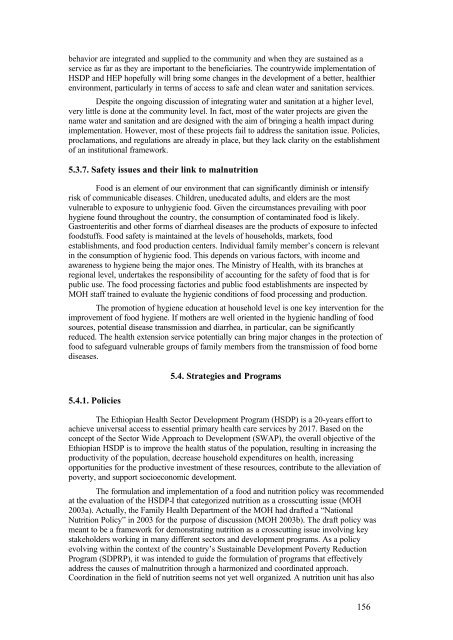An assessment of the causes of malnutrition in Ethiopia: A ...
An assessment of the causes of malnutrition in Ethiopia: A ...
An assessment of the causes of malnutrition in Ethiopia: A ...
You also want an ePaper? Increase the reach of your titles
YUMPU automatically turns print PDFs into web optimized ePapers that Google loves.
ehavior are <strong>in</strong>tegrated and supplied to <strong>the</strong> community and when <strong>the</strong>y are susta<strong>in</strong>ed as a<br />
service as far as <strong>the</strong>y are important to <strong>the</strong> beneficiaries. The countrywide implementation <strong>of</strong><br />
HSDP and HEP hopefully will br<strong>in</strong>g some changes <strong>in</strong> <strong>the</strong> development <strong>of</strong> a better, healthier<br />
environment, particularly <strong>in</strong> terms <strong>of</strong> access to safe and clean water and sanitation services.<br />
Despite <strong>the</strong> ongo<strong>in</strong>g discussion <strong>of</strong> <strong>in</strong>tegrat<strong>in</strong>g water and sanitation at a higher level,<br />
very little is done at <strong>the</strong> community level. In fact, most <strong>of</strong> <strong>the</strong> water projects are given <strong>the</strong><br />
name water and sanitation and are designed with <strong>the</strong> aim <strong>of</strong> br<strong>in</strong>g<strong>in</strong>g a health impact dur<strong>in</strong>g<br />
implementation. However, most <strong>of</strong> <strong>the</strong>se projects fail to address <strong>the</strong> sanitation issue. Policies,<br />
proclamations, and regulations are already <strong>in</strong> place, but <strong>the</strong>y lack clarity on <strong>the</strong> establishment<br />
<strong>of</strong> an <strong>in</strong>stitutional framework.<br />
5.3.7. Safety issues and <strong>the</strong>ir l<strong>in</strong>k to <strong>malnutrition</strong><br />
Food is an element <strong>of</strong> our environment that can significantly dim<strong>in</strong>ish or <strong>in</strong>tensify<br />
risk <strong>of</strong> communicable diseases. Children, uneducated adults, and elders are <strong>the</strong> most<br />
vulnerable to exposure to unhygienic food. Given <strong>the</strong> circumstances prevail<strong>in</strong>g with poor<br />
hygiene found throughout <strong>the</strong> country, <strong>the</strong> consumption <strong>of</strong> contam<strong>in</strong>ated food is likely.<br />
Gastroenteritis and o<strong>the</strong>r forms <strong>of</strong> diarrheal diseases are <strong>the</strong> products <strong>of</strong> exposure to <strong>in</strong>fected<br />
foodstuffs. Food safety is ma<strong>in</strong>ta<strong>in</strong>ed at <strong>the</strong> levels <strong>of</strong> households, markets, food<br />
establishments, and food production centers. Individual family member’s concern is relevant<br />
<strong>in</strong> <strong>the</strong> consumption <strong>of</strong> hygienic food. This depends on various factors, with <strong>in</strong>come and<br />
awareness to hygiene be<strong>in</strong>g <strong>the</strong> major ones. The M<strong>in</strong>istry <strong>of</strong> Health, with its branches at<br />
regional level, undertakes <strong>the</strong> responsibility <strong>of</strong> account<strong>in</strong>g for <strong>the</strong> safety <strong>of</strong> food that is for<br />
public use. The food process<strong>in</strong>g factories and public food establishments are <strong>in</strong>spected by<br />
MOH staff tra<strong>in</strong>ed to evaluate <strong>the</strong> hygienic conditions <strong>of</strong> food process<strong>in</strong>g and production.<br />
The promotion <strong>of</strong> hygiene education at household level is one key <strong>in</strong>tervention for <strong>the</strong><br />
improvement <strong>of</strong> food hygiene. If mo<strong>the</strong>rs are well oriented <strong>in</strong> <strong>the</strong> hygienic handl<strong>in</strong>g <strong>of</strong> food<br />
sources, potential disease transmission and diarrhea, <strong>in</strong> particular, can be significantly<br />
reduced. The health extension service potentially can br<strong>in</strong>g major changes <strong>in</strong> <strong>the</strong> protection <strong>of</strong><br />
food to safeguard vulnerable groups <strong>of</strong> family members from <strong>the</strong> transmission <strong>of</strong> food borne<br />
diseases.<br />
5.4.1. Policies<br />
5.4. Strategies and Programs<br />
The <strong>Ethiopia</strong>n Health Sector Development Program (HSDP) is a 20-years effort to<br />
achieve universal access to essential primary health care services by 2017. Based on <strong>the</strong><br />
concept <strong>of</strong> <strong>the</strong> Sector Wide Approach to Development (SWAP), <strong>the</strong> overall objective <strong>of</strong> <strong>the</strong><br />
<strong>Ethiopia</strong>n HSDP is to improve <strong>the</strong> health status <strong>of</strong> <strong>the</strong> population, result<strong>in</strong>g <strong>in</strong> <strong>in</strong>creas<strong>in</strong>g <strong>the</strong><br />
productivity <strong>of</strong> <strong>the</strong> population, decrease household expenditures on health, <strong>in</strong>creas<strong>in</strong>g<br />
opportunities for <strong>the</strong> productive <strong>in</strong>vestment <strong>of</strong> <strong>the</strong>se resources, contribute to <strong>the</strong> alleviation <strong>of</strong><br />
poverty, and support socioeconomic development.<br />
The formulation and implementation <strong>of</strong> a food and nutrition policy was recommended<br />
at <strong>the</strong> evaluation <strong>of</strong> <strong>the</strong> HSDP-I that categorized nutrition as a crosscutt<strong>in</strong>g issue (MOH<br />
2003a). Actually, <strong>the</strong> Family Health Department <strong>of</strong> <strong>the</strong> MOH had drafted a “National<br />
Nutrition Policy” <strong>in</strong> 2003 for <strong>the</strong> purpose <strong>of</strong> discussion (MOH 2003b). The draft policy was<br />
meant to be a framework for demonstrat<strong>in</strong>g nutrition as a crosscutt<strong>in</strong>g issue <strong>in</strong>volv<strong>in</strong>g key<br />
stakeholders work<strong>in</strong>g <strong>in</strong> many different sectors and development programs. As a policy<br />
evolv<strong>in</strong>g with<strong>in</strong> <strong>the</strong> context <strong>of</strong> <strong>the</strong> country’s Susta<strong>in</strong>able Development Poverty Reduction<br />
Program (SDPRP), it was <strong>in</strong>tended to guide <strong>the</strong> formulation <strong>of</strong> programs that effectively<br />
address <strong>the</strong> <strong>causes</strong> <strong>of</strong> <strong>malnutrition</strong> through a harmonized and coord<strong>in</strong>ated approach.<br />
Coord<strong>in</strong>ation <strong>in</strong> <strong>the</strong> field <strong>of</strong> nutrition seems not yet well organized. A nutrition unit has also<br />
156
















